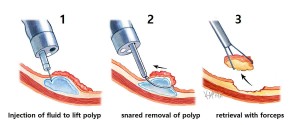.
Endoscopic mucosal resection (EMR) involves:
- the injection of a solution into the submucosal layer of the bowel wall; and
- En bloc or piecemeal resection of the lesion using a snare.
Injection fluid has traditionally been normal saline, however more recently better results have been achieved with a mixture of succinylated gelatin (Gelofusin®) with a blue colour dye (methylene blue) and adrenaline to cause vasoconstriction [2].

By injection underneath the large polyp, it allows the polyp to be lifted up off of the underlying colon wall, thus allowing more easy inclusion of the lesion in a large snare, which reducing the risk of thermal injury and perforation to the underlying colon. The main disadvantage of this technique is that piecemeal removal of the polyp is often required for very large polyps, leading to potential error when assessing the specimen for underlying cancer.
References
- Rembacken BJ. Fujii T. Cairns A. Dixon MF. Yoshida S. Chalmers DM. Axon AT Flat and depressed colonic neoplasms: a prospective study of 1000 colonoscopies in the UK. Lancet. 355(9211):1211-4, 2000 Apr 8.
- Moss A. Bourke MJ. Kwan V. Tran K. Godfrey C. McKay G. Hopper AD. Succinylated gelatin substantially increases en bloc resection size in colonic EMR: a randomized, blinded trial in a porcine model. Gastrointestinal Endoscopy. 71(3):589-95, 2010 Mar.

